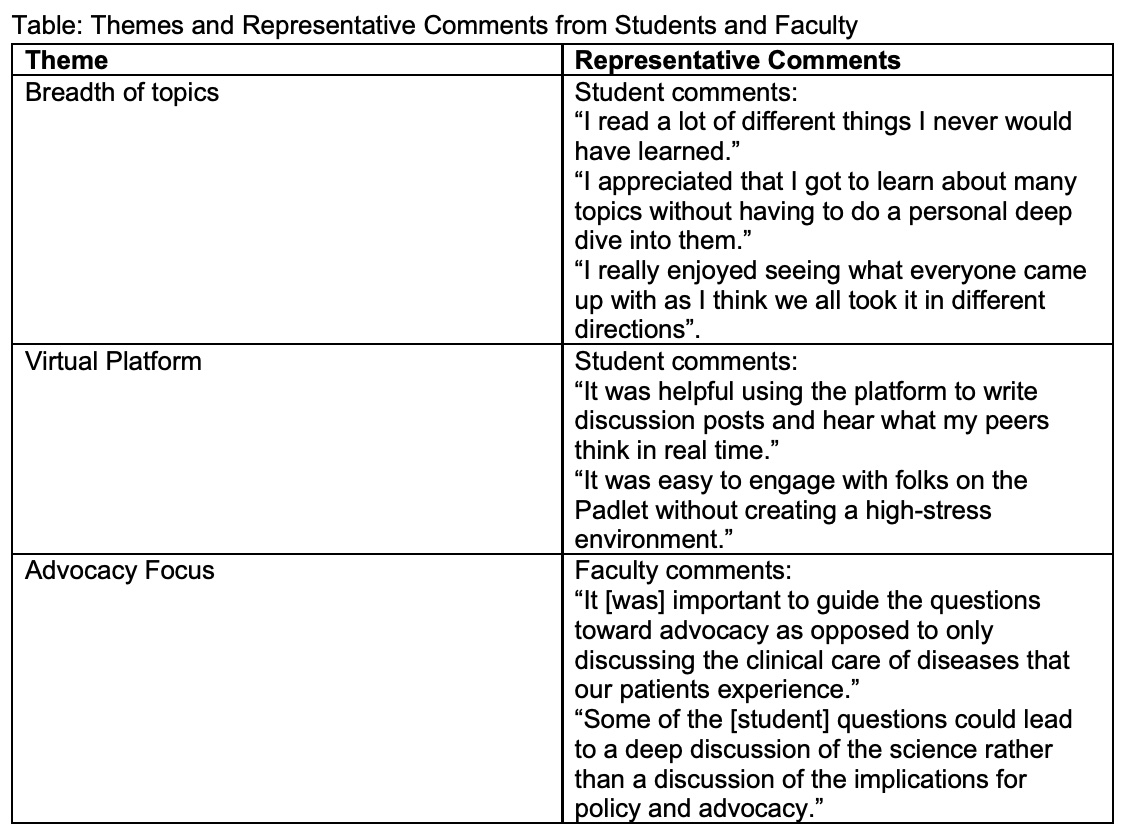Medical Education
Session: Medical Education 2
539 - Teaching Medical Students Advocacy Through a Virtual Journal Club
Friday, May 3, 2024
5:15 PM - 7:15 PM ET
Poster Number: 539
Publication Number: 539.512
Publication Number: 539.512
- ZL
Zoe C. Lee-Chiong, MS (she/her/hers)
Medical Student
University of Colorado School of Medicine
Aurora, Colorado, United States
Presenting Author(s)
Background: Advocacy skills are essential to the practice of medicine and are a curricular element at many medical schools. Journal clubs allow learners to explore the evidence base of medicine but are seldom used to connect evidence to policy issues that affect patients and communities. We developed an Advocacy Journal Club for student-led learning about evidence-based policy and advocacy during their longitudinal integrated clerkship (LIC) year.
Objective: Design, implement and evaluate an Advocacy Journal Club for clerkship medical students. The learning objectives were to learn about different advocacy topics, interact with advocacy experts, and lead a virtual journal club.
Design/Methods: Journal club sessions were scheduled quarterly over the clerkship year. Journal clubs occurred virtually on Padlet, a free online platform that allows sharing of content on any device. Prior to each session, instructions about journal club format and Padlet were provided. Three student leaders were assigned to lead each session, and a faculty advocacy expert was identified to participate. Student leaders chose an advocacy topic, selected articles and prepared discussion questions with the advocacy expert. Student participants reviewed articles prior to each session. Journal club sessions lasted one hour during which time students and faculty commented on advocacy discussion questions pertaining to the chosen articles on Padlet.
The evaluation consisted of tabulation of the advocacy topics covered. Preparatory emails between and student leaders and advocacy experts, journal club discussions, and course evaluation comments were reviewed and summarized.
Results: This intervention was implemented with 24 students in 2 LIC cohorts. Five journal club sessions were held over the course of 12 months, with 15 student leaders. Student-chosen advocacy topics included childhood vaccines, social media as a source of medical information, food insecurity, residency unions, and climate change. Preparatory email conversations as well as journal club discussion threads demonstrate frequent redirection of students by faculty experts towards advocacy focus, rather than clinical or research-based focus (see Table). Course evaluation comments demonstrate student engagement in different advocacy topics.
Conclusion(s): Use of a virtual journal club was a viable option for teaching advocacy topics to clerkship medical students. Students appreciated the opportunity to explore a variety of advocacy topics throughout the year and learn from their peers. An advocacy expert is necessary to guide student discussion toward an advocacy lens.

